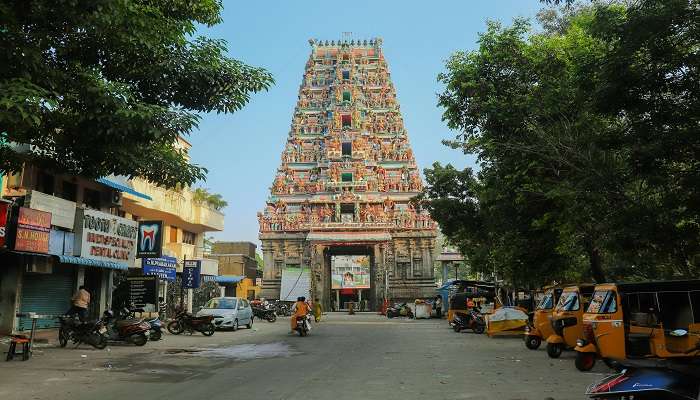Spend Time Amidst Nature At The Hollongapar Gibbon Sanctuary In 2025
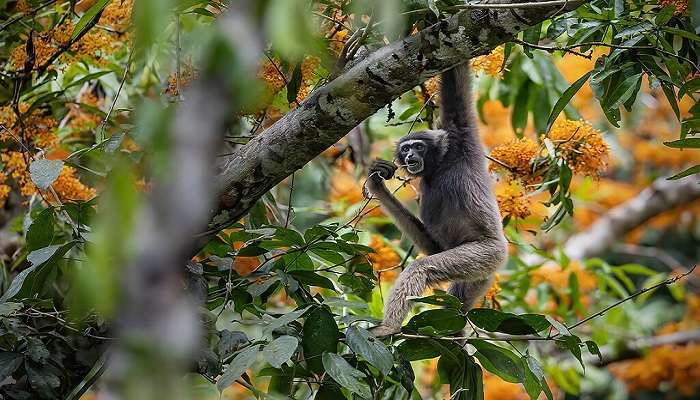
Nestled in the lush forests of Assam, the Hollongapar Gibbon Sanctuary stands as a hidden gem for wildlife enthusiasts and nature lovers alike. This protected area is one of the last refuges for the endangered western hoolock gibbon, India’s only ape species. Beyond its namesake, the sanctuary harbours a diverse ecosystem teeming with rare, exotic flora and fauna. From the canopy-dwelling gibbons to the elusive clouded leopards roaming the forest floor, Hollongapar offers visitors a unique glimpse into one of Northeast India’s most precious natural treasures.
About Hollongapar Gibbon Sanctuary
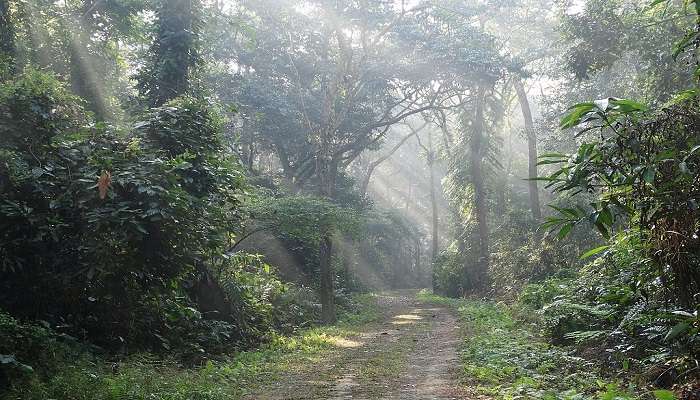
The Hollongapar Gibbon Sanctuary, previously known as the Gibbon Wildlife Sanctuary or Hollongapar Reserved Forest, is a significant protected area in Assam in India. Established officially in 1997 and initially set aside in 1881, this sanctuary is nestled in evergreen forests that once stretched to the foothills of the Patkai mountain range.
Over time, the sanctuary has become isolated, surrounded by tea gardens and small villages, which has led to habitat fragmentation. However, efforts were made in the early 1900s to artificially regenerate the forest, resulting in a diverse and well-stocked ecosystem. The sanctuary is notable for several key species. It is home to India’s only ape and gibbon species, the hoolock gibbons, known for their characteristic calls echoing through the forest canopy. Additionally, it harbours Northeastern India’s only nocturnal primate, the Bengal slow loris.
Also Read: Things To Do In Jorhat
History Of Hollongapar Gibbon Sanctuary
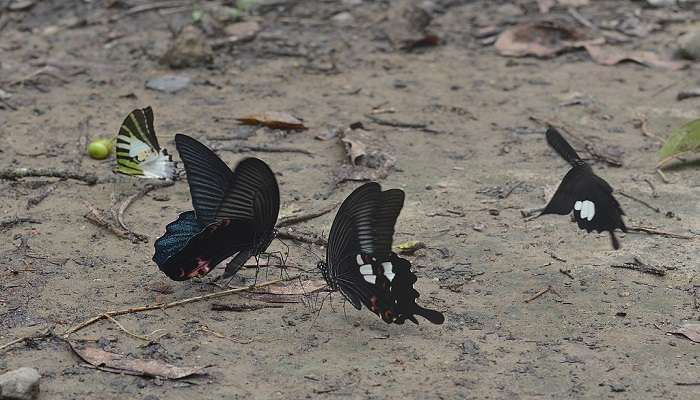
Located in Jorhat district in Assam, it was initially designated as a “Reserve Forest” on 27 August 1881, owing its name to the dominant tree species, hollong or Dipterocarpus macrocarpus. Originally part of the foothill forests of the Patkai mountain range, it was initially spread over 206 hectares (0.80 sq mi). However, its area decreased over time due to de-reservation actions in 1896. The sanctuaries underwent significant changes as tea gardens emerged between 1880 and 1920, and villages were established in the 1960s for displaced populations from Majuli and nearby areas affected by floods. These developments fragmented the forest, isolating the reserve from its foothill connections.
Efforts to regenerate the forest included introducing artificial plantations alongside natural vegetation and fostering diverse flora and fauna. By the 1990s, the sanctuary had expanded to encompass 2,098.62 hectares (8.1 sq mi) despite its fragmented state into five distinct segments. On 30 July 1997, the sanctuary was formally constituted under the Jorhat district and named “Gibbon Sanctuary, Meleng” after the hoolock gibbons, the only apes found in India. Due to its significant population of these primates, the Sanctuary was later correctly renamed the “Hollongapar Gibbon Sanctuary” by the Assam Government on 25 May 2004. Today, the Hollongapar Gibbon Sanctuary stands as a crucial refuge for biodiversity, particularly known for its dense population of hoolock gibbons. It continues to face challenges associated with its fragmented habitat amidst tea gardens and human settlements.
Flora At Hollongapar Gibbon Sanctuary
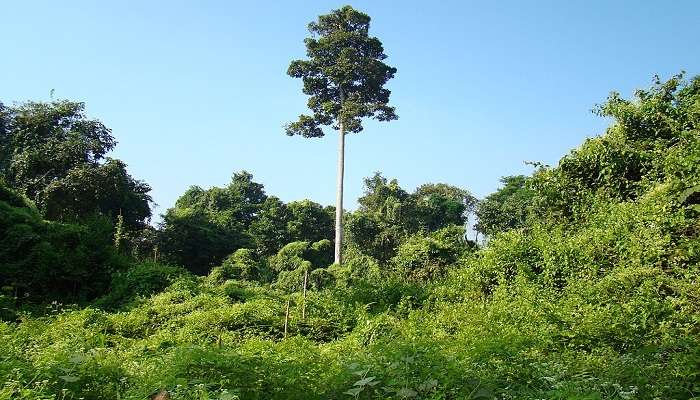
The Hollongapar Gibbon Sanctuary features a lush, evergreen canopy that is divided into distinct layers. At the top, towering trees like Dipterocarpus macrocarpus dominate, alongside species such as Sam, Amari, Sopas, Bhelu, Udal, and Hingori. Below them, the middle canopy is characterised by Nahor trees, which cast dense shade over a wide area, accompanied by Bandordima, Dhuna, Bhomora, Ful Gomari, Bonbogri, Morhal, Selleng, Sassi, and Otenga.
Closer to the ground, a variety of evergreen shrubs and herbs, including Dolu Bamboo, Bojal Bamboo, Jengu, Jati Bet, Houka Bet, Tora, Kaupat, and Sorat, make up the lower canopy and ground layers. This vegetation structure supports a diverse ecosystem within the sanctuary, which is essential for conserving its wildlife, including the endangered Western Hoolock Gibbon.
Related Post: Hill Stations Near Guwahati
Fauna At Hollongapar Gibbon Sanctuary
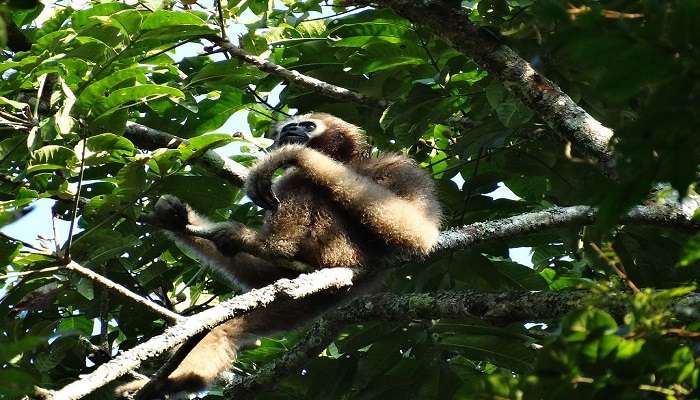
Hollongapar Gibbon Sanctuary is renowned for its rich biodiversity, hosting several notable species. It is the exclusive habitat of India’s only ape, the Western Hoolock Gibbon, with a population of 125 individuals as of 2023. Additionally, the sanctuary shelters the Bengal Slow Loris, the sole nocturnal primate in northeast India. Other primates found here include the stump-tailed macaque, northern pig-tailed macaque, eastern Assamese macaque, rhesus macaque, and capped langur.
The sanctuary’s fauna also includes Indian elephants, leopards, jungle cats, wild boar, various civet species, and several squirrels. It is home to at least 219 bird species and numerous snake varieties. Moreover, the sanctuary boasts a diverse butterfly population, with 211 species recorded. Unfortunately, the tiger, once present, is now locally extinct in the area.
Hollongapar Gibbon Sanctuary Opening Hours and Entry Fees
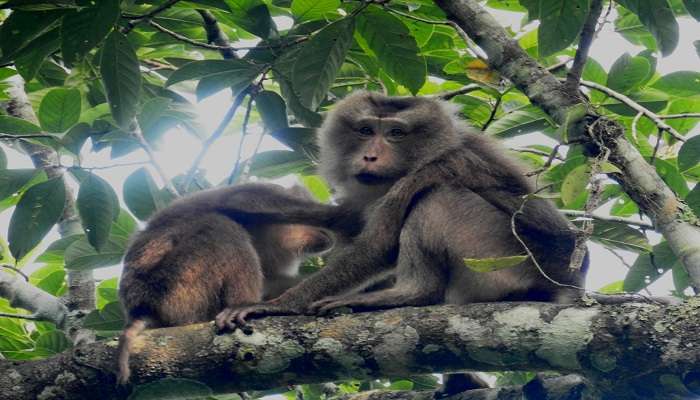
The Hollongapar Gibbon Sanctuary, a renowned wildlife reserve known for its rich biodiversity, is open from 6:00 PM to 12 AM. Although it remains open 24 hours, early morning visits are recommended for the best wildlife viewing.
Entry costs Rs. 250 per person, with an additional Rs. 500 fee for DSLR cameras. Prior permission is required for professional filming. A guide is mandatory for all visits. Explore and enjoy this extraordinary sanctuary!
Related Post: Churches In Guwahati
Ways To Reach

To reach Hollongapar Gibbon Sanctuary, you have several transportation options. Some of the most popular ones include:
By Air: The nearest airport is located in Jorhat, approximately 22 Km away from the sanctuary. From the airport, you can easily hire a cab to reach your destination in Hoollongapar Gibbon Wildlife Sanctuary.
By Rail: The closest railway station is in Mariani, which is very near to the sanctuary. It takes just 5 minutes by cab to reach the sanctuary from Mariani railway station. Walking is also a feasible option.
By Road: Hoollongapar Gibbon Wildlife Sanctuary is well-connected by road. It is a prominent sanctuary in the Jorhat region. You can reach the sanctuary conveniently by cab or public and private buses from various locations.
Things To Keep In Mind While Visiting The Sanctuary
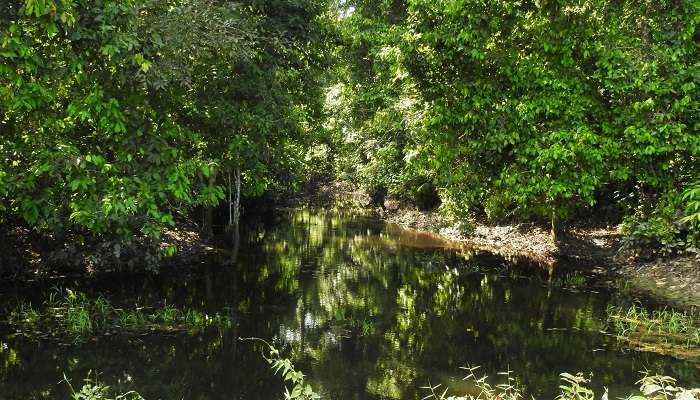
Below are some important things to keep in mind while visiting this sanctuary:
Respect the Wildlife: The sanctuary is home to various species of primates and birds. It’s crucial to maintain a safe distance and avoid feeding or disturbing them.
Guided Tours: It’s recommended to take a guided tour. The guides know the local flora and fauna and can enhance your experience.
Dress Appropriately: Wear comfortable walking shoes and clothes in muted colours that blend with the surroundings. This helps in not disturbing the wildlife.
Carry Essentials: Don’t forget to carry water, snacks, binoculars, and a camera. However, littering is strictly prohibited.
Follow the Rules: Adhere to the sanctuary rules, such as maintaining silence, not using flash photography, and sticking to the designated paths.
Best Time to Visit: The best time to visit is during the early morning hours when the animals are most active.
You May Also Like To Read: Waterfalls In Assam
The Hollongapar Gibbon Sanctuary in Assam is an excellent destination for those who like nature and wildlife. It’s a place where you can see rare monkeys living freely in the wild. The sanctuary is also important for protecting these animals. It’s full of different types of plants and animals, which makes it a great place to visit for a real-life nature experience. Are you excited to see some animals? Make sure you visit this amazing sanctuary to see the beautiful wildlife of Assam. Book your trip to Assam today and immerse yourself in the lush forests of Hollongapar. Your adventure awaits!
For our editorial codes of conduct and copyright disclaimer, please click here.
Cover Image Credit: JJ Harrison for wikimedia commons
Frequently Asked Questions About Hollongapar Gibbon Sanctuary
What is the Hoollongapar Gibbon Sanctuary famous for?
The Hoollongapar Gibbon Sanctuary is renowned for its rich biodiversity and is notably home to India’s only ape species, the Hoolock Gibbons. It is a protected area of evergreen forest located in Assam, India, dedicated to conserving the endangered Western Hoolock Gibbon.
What is Gibbons famous for?
Gibbons are known for their acrobatic brachiation (swinging from branch to branch) and melodious vocalizations. They are slender, long-limbed apes found in tropical and subtropical forests of Southeast Asia. Their loud, penetrating calls are distinctive in the forest canopy.
What animals are in the Gibbon Wildlife Sanctuary?
The sanctuary hosts a diverse range of mammals including elephants, leopards, tigers, pangolins, various macaque species, langurs, slow lorises, jungle cats, civets, giant squirrels, and more. It also supports a variety of bird species like the Indian Pied Hornbill, Osprey, Hill Myna, and Kalij Pheasant, along with reptiles such as the Indian Python and Common Monitor Lizard.
What is the history of Gibbon Wildlife Sanctuary?
Initially established as a reserved forest in 1881, the sanctuary gained official status in 1997. Named after its dominant tree species, Hollong (Dipterocarpus macrocarpus), the area underwent artificial regeneration efforts in the early 1900s to enhance its forest cover and biodiversity. Today, it faces challenges due to surrounding tea gardens and villages.
What is the climate in Gibbon Wildlife Sanctuary?
The sanctuary, situated in Assam, India, experiences a tropical monsoon rainforest climate with significant annual rainfall averaging 249 cm. The weather is hazy, with a temperature of approximately 27 degrees Celsius.
People Also Read:
Orchha Wildlife Sanctuary Sakteng Wildlife Sanctuary Idukki Wildlife Sanctuary

With a passion for exploring and travelling to the roads long forgotten, experience the world through enthralling stories and adventures. Join me as I share my experiences at some of the world’s most popular tourist destinations and quench that pestering curiosity with something exciting!




